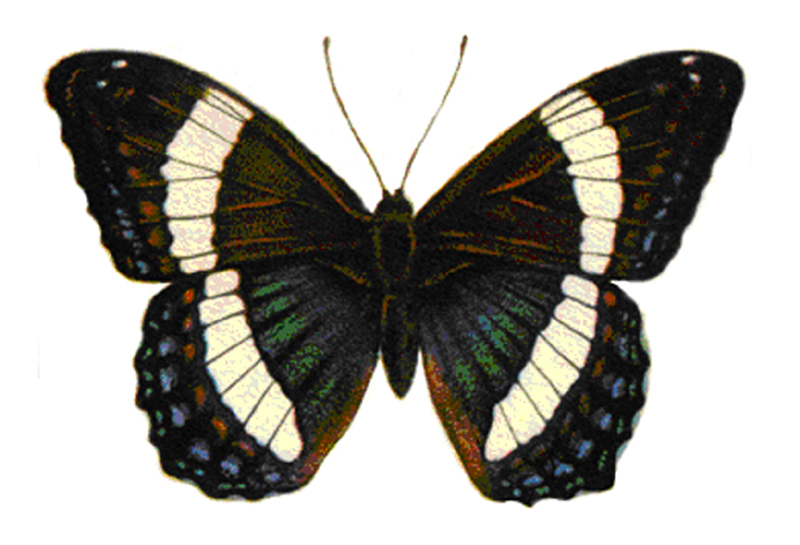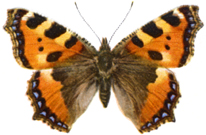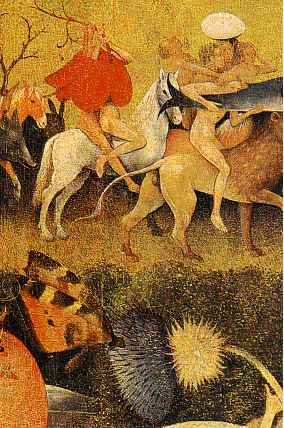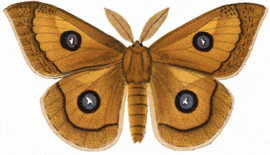Butterflies and Moths in Nabokov's Published Writings
Alphabetical Order ‒ Page 1
* A * ... B-C ... D-E ...
Aaron's Skipper: »Poanes aaroni
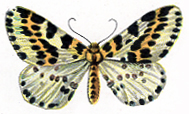
Abraxas grossulariatus (Nemos, 1910)
Abraxas grossulariatus Linnaeus, 1758 [Geometridae, Ennominae]: a striking geometer moth with a wingspan of 32 to 48 mm and several rows of black dots on white ground, interconnected by yellow, densest on the forewings. It flies in July and August in all of middle and northern Europe including Russia, mostly in gardens. The larvae feed on gooseberry bushes (Ribes uva-crispa) and Prunus padus. Its common name in Russian, German and Spanish is equal to 'harlequin.' Possibly this is the moth referred to by Vadim's (the narrator's) grand-aunt and consequently by the title of his highly unreliable "autobiography", Look at the Harlequins!. However, on another page (p. 108−109), Vadim himself wronly identifies another butterfly as a 'harlequin' which turns out to be Aglais urticae (L. 1758), the Small Tortoiseshell or Nettefly.
* LHarl 8-9
& Ac: Abráxas grossulariátus • En: Magpie, Currant Moth • Ge: Stachelbeerspanner, Harlekin, Tintenfleck • Fr: la Zérène du grosseillier, la Phalène mouchetée • Ru: Пяденица крыжовниковая, арлекин • Sp: geometra arlequín
Acherontia atropos (Hübner 1793-1827)
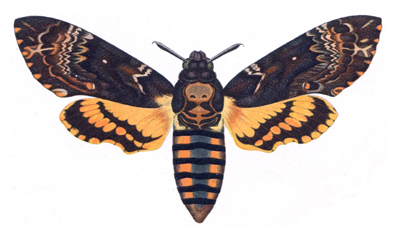
Acherontia atropos Linnaeus, 1758 [Sphingidae, Sphinginae]: this mythic creature is a large hawk moth (wingspan 80–120 mm) with a striking distinguishing mark: a sort of death's head on the back of its thorax. It migrates from Africa and SW Asia to Europe each May and June and is known to mob beehives in order to rob honey. It does not occur in America, as Poe seems to have thought.
*Gift 110; SelLet 257; NabBut 199 (FB)
& Ac: Acheróntia átropos • En: Death's Head Moth • Fr: le sphinx tête de mort, (Don) le sphinx atropos • Ge: Totenkopf(schwärmer) • It: testa di morto, atropo • Ru: (DarII) бражник «мертвая голова» • Sp: calavera
Acidalia Hübner, 1819: an abandoned name of a genus of »Nymphalidae, subfamily Heliconiinae, tribe Argynnini. The name is an invalid synonym of Argyreus Scopoli, 1777. The type-species is Argyreus hyperbius Linnaeus, 1763, the Indian Fritillary, in Sri Lanka, Himalayas, Baluchistan, China, Japan, Australia.
"Or else such trifles, unforgettable for me, as the line referring to a pair of a new species of Acidalia 'once brought to me by Dr. P.P. Paradizov, who had taken them off a wall in the Astrakhan railroad station on October 11, 1889."
*NabBut 211 (FB)
Scopula virgulata (P.E.Böklin Naturhistorika riksmuseet)
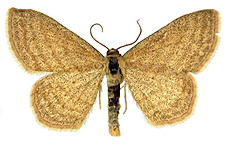
Acidalia TREITSCHKE, 1825, was a large genus of »Geometridae (Sterrhinae) with over 800 species which has been split in a number of different genera. It is not quite clear whether Acidalia was replaced by Scopula SCHRANK, 1822 because the name had proved to be preoccupied by Acidalia HÜBNER, 1819 (see above) or whether it remains in existence as an unranked synonym. Newer entomologists anyway seem to prefer Scopula. The type species of Acidalia was what is now Scopula virgulata DENIS & SCHIFFERMÜLLER, 1775. The wingspan of Scopula moths is c. 20-30 mm, the basic color is white, gray, yellowish or brown – mostly on the light side. The genus is predominantly tropical and subtropical. In Georgia, Nabokov may have seen Scopula ordinata WALKER, 1861 at his window.
*LtVé 467
Acronicta (not Acronycta) pontica: »Craniophora pontica
Actias luna (Holland 1903)
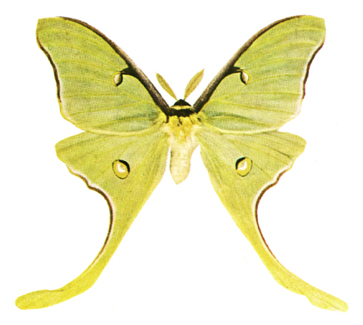
Actias luna Linnaeus, 1758 [Saturniidae]: a night-flying Emperor moth which, in human terms, might be said to look beautifully decadent. That is an impression arising when some creature has evolved very far and seemingly without purpose into one very special direction. The Luna Moth has a plump, short, furry white body and a wingspan of 75–110 mm. The wings are a very pale green with delicate yellow veins, a narrow red border and an eyespot on each wing. Its most salient feature, however, are the exaggerated and partially crumpled hindwing tails (30 mm or more). It is quite common all over N America, from Canada to Mexico. There is a close relative in SE Asia, Actias selene Hübner, 1807, with a yellowish hue and even longer tails. The only European relative is »Graellsia isabellae Graells, 1849, in Spain.
*PaleF 114; StrOps 329; N/WLet #142=113old
& Ac: Áctias lúna • En: Indian Moonmoth • Am: American Moon Moth • Ge: *Amerikanischer, Asiatischer Mondspinner • Ru: сатурная луна
Adakisme: this, along with "Marykisme" and "Ohkisme", pretends to be the name of some microlepidopteron, created by "a well-known microlepidopterist" in Ada. In reality, it is playful allusion to a joke the British-American entomologist George Willis Kirkaldy permitted himself at the beginning of the 20th century when he dealt several species of Hemiptera (not microlepidopera) whimsical names that ended in "-chisme" (pronounced -kissme). Biologist and Nabokov expert Victor Fet has the story: "In 1904, the renowned British-American entomologist George Willis Kirkaldy (who worked on so-called true bugs, order Hemiptera), created a series of generic names for his beloved bugs, among them: Ochisme, Dolichisme, Elachisme, Florichisme, Isachisme, Marichisme, Nanichisme, Peggichisme, and Polychisme ... Kirkaldy died in 1910 in San Francisco, aged only 36. In 1912, he was posthumously criticized for frivolity by the Zoological Society of London. All these bug names, however, were, and are, perfectly available according to zoological nomenclature, although some of them were synonymized since 1904. I do not know where in his entomological career did Nabokov pick up George Kirkaldy’s precious pun. It has been known to many; it is still around, now mostly on the trivia websites. However, the original Kirkaldy paper, "Bibliographical and nomenclatorial notes on the Hemiptera. No. 3", appeared in the famous British journal, The Entomologist (1904, 37: 279-283). Nabokov’s own first publication in English, “A Few Notes on Crimean Lepidoptera” (1920), appeared in the same journal, one of his favorite ... Nabokov read this journal for decades: he wrote to his wife from Prague in 1930 how he "... gnawed into old numbers of The Entomologist ..." Would it be too much to assume that Nabokov had in fact seen the original Kirkaldy publication in his young years in Russia? Already by 1910, he was "voraciously reading entomological periodicals, especially English and Russian ones" (Speak, Memory, 6.2); among them the English 'were then the best in the world' (Drugie berega, 6.2, in Russian) ... Nabokov used three names in Ada: one is Adakisme; two others, Ohkisme and Marykisme, are original Kirkaldy’s names, Ochisme and Marichisme ... Kirkaldy created many other whimsical generic names such as Apache, Geisha, Nirvana, Peregrinator, and Texas; one of his 1902 names even honored the Hawaiian king, Kamehameha ... The fact that in Ada Nabokov ascribes Kirkaldy-style names to 'a well-known microlepidopterist' (while Kirkaldy was a well-known hemipterist) appears to be an intentional hoax, designed to confuse a future Nabokovian who would search in vain for these names among Microlepidoptera (the suborder of Lepidoptera that includes small moths), and after not finding any would shrug these names off as another unexplained quirk of Nabokov’s ebullient fantasy. Indeed, by the time of Ada writing, the multitude of lepidopteran motifs in Nabokov’s ouevre was already so well-known and overinterpreted that planting a fake lepidopteran reference among many real ones seems very much fitting in Ada’s deceptive antiworld" (Victor Fet: "Adakisme, Dolikisme: The Kirkaldy Connection", The Nabokovian, no.56, Spring 2006, p.14-19).
*Ada 141
Adelpha Hübner, 1819: a genus of »Nymphalidae, subfamily Limenitidinae (admirals). The type-species is Adelpha mesentina Cramer, 1777.
Adelpha iphicla Linnaeus, 1758 [Nymphalidae]: a brown admiral with a white band across fore- and hindwings and orange blots in the corners, wingspan 40 mm. In Mexico, C America, Brazil.
*SelLet 481
admirable: an eighteenth century spelling of what today is commonly called an 'admiral'. Nabokov greatly preferred the old name. It was brought into use if not invented by Moses Harris in his popular butterfly book The »Aurelian (1766 etc.). In a broad sense, the species in the subfamily Limenitidinae of »Nymphalidae are all called admirals (mainly in the genera Limenitis Fabricius, 1807 and Basilarchia Scudder, 1872) and some species in the subfamily Nymphalinae as well (mainly in the genus Vanessa Fabricius, 1807). In the narrowest sense, it is only the Red Admiral, »Vanessa atalanta.
|
Polygonia interrogationis (Seitz 1924) |
Basilarchia arthemis (Weed 1927) |
|
|
|
Admirable Anglewing, The: this was the title of the last story Nabokov in 1958/59 and again in 1966 wanted to write and which he never finished. The drafts have been published in Nabokov's Butterflies. Brian Boyd writes (VNAY, p. 379): "… it appears that the story would have told of an entomologist who lends a fantastic butterfly rarity, perhaps a genetic aberration, perhaps a new species, to a colleague, only for someone in the latter's family to lose or destroy the specimen and attempt to substitute a black-and-white Admirable whose wings have been cut out to match the alar contours of the missing prize – a ploy hideously unconvincing to a lepidopterist's eye." The rare specimen must be a member of the genus Polygonia Hübner, 1819 [Nymphalidae], characterized by its wildly ragged wing contours. Indeed, they look a little as if they had been cut out by a child with a nail-scissors. This has earned the genus the English name »anglewings. From the notes it appears that the particular anglewing Nabokov had in mind was the Question Mark (Polygonia interrogationis Fabricius, 1798) – a N American species with a wingspan of 60–67 mm and ragged wing margins, rust-orange with dark blotches, flying east of the Rocky Mountains from Canada to Mexico and in the SE Atlantic States. The relatively ordinary substitute that is made to look like it could be either of these two, as one of the experts in the story suggests: (1) »Basilarchia arthemis Drury, 1773, one of the few American 'admirables' that are predominantly coal-black and milk-white, with a blue or blue-green iridescence on the hindwings. The wingspan is 73–79 mm, the range Alaska and British Columbia and from Minnesota and Manitoba to New York and Maine. (2) Basilarchia weidemeyerii W.H. Edwards, 1863 (not wiedemeyerii), coal-black and white, without the blue-green reflections of arthemis and flying east of the Rocky Mountains. Note that Admirals and the Question Mark are as unlike as can be.
*NabBut 538–544; Boyd VNAY 365, 379, 385, 508
& Ac: Polygónia interrogatiónis • Am: Question Mark • Ge: *Fragezeichen-Zackenfalter
& Ac: Basilárchia árthemis • Am: White Admiral, Banded Purple, Artemis Limenite • Ge: *Artemis-Eisvogel
& Ac: Basilárchia weideméyerii • Am: Weidemeyer's Admiral • Ge: *Weidemeyers Eisvogel
Adopoea Billberg, 1820: an abandoned genus of »Hesperiidae (skippers), Hesperiinae. The type-species was Thymelicus sylvestris Poda 1761, the Small Skipper, in Morocco, Europe, Asia Minor, Iran. According to Nabokov, it was one of the five genera of the family represented in Europe; there are at least thirteen now.
*NabBut 611 (BE)
Adopaea flava: »Thymelicus flava
Adorata adorata: a wholly imaginary (nymphalid?) butterfly Nabokov drew for his wife on January 5, 1970.
*Véra's Butterflies, p. 115; NabBut plate 3
Adorina verae Nab.: "Véra's Adorina", a multicolored imaginary butterfly Nabokov drew for his wife, Christmas 1974. In this case the genus is also imaginary. *Véra's Butterflies, p. 43
Aellopos titan & hummingbird (Bates 1863)
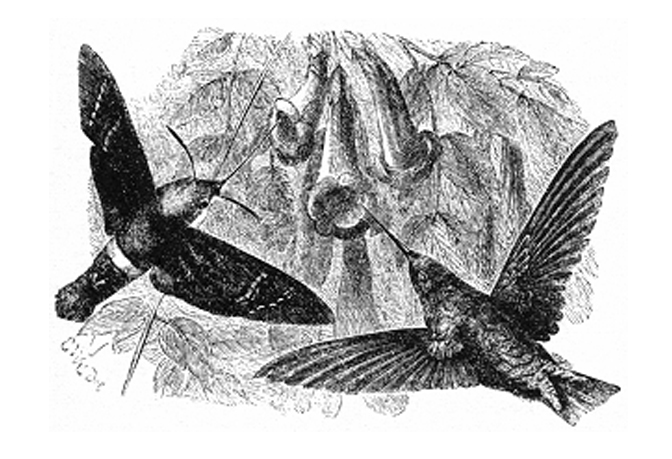
*Aellopos titan Cramer, 1777 [Sphingidae, Macroglossinae]: among the cases of mimicry or imitation mentioned in The Gift, there is a "cunning butterfly in the Brazilian forest which imitates the whir of a local bird". Which is it?
There are a few butterflies that produce noises, notably those of the genus Hamadryas Hübner, 1806. They are rather large and colorful nymphalids at home in tropical S America whose males make a rapid clicking or rustling noise ("like burning pine needles") when in flight, probably to alert conspecifics of their sex. This noise is said to be most pronounced in the species fornax Hübner, 1823, belladonna Bates, 1865 on the upper Amazonas and arethusa Cramer, 1775 (En: Queen Cracker) ranging from Mexico to Bolivia. Because of it, the members of this genus are called 'Crackers' or 'Clicks' in English and 'Klappervögel' in German. However, neither can a crackling noise be called a whir, nor is it known to imitate any bird.
Another possibility is that what Nabokov had in mind was the small tribe of »Brassolini in C and S America, comprising around eighty species. Its largest members belong to the C American genus Caligo Hübner, 1819 (type-species »Caligo eurilochus CRAMER, 1775), with wingspans up to 200 mm and large eyespots on the underside of their hindwings which when flourished give them a decidedly owl-like appearance, earning the Brassolini the name "Owls". Some Caligo species are pests, feeding on banana plantations. When in flight, their huge wings produce a rustling noise intended to scare off birds, yet a rustle is not quite a whir, and it is not known to imitate anything.
My hypothesis is that the remark refers to a passage in Henry Walter »Bates' The Naturalist on the river Amazons with which Nabokov seems to have been thoroughly familiar (cf. Thomas »Barbour): "Several times I shot by mistake a humming-bird hawk-moth instead of a bird. This moth (Macroglossa Titan) is somewhat smaller than hummingbirds generally are; but its manner of flight, and the way it poises itself before a flower whilst probing it with its proboscis, are precisely the same actions as of humming-birds. It was only after many days' of experience that I learnt to distinguish one from the other when on the wing. This resemblance has attracted the notice of the natives, all of whom, even educated whites, firmly believe that one is transmutable into the other … But, of course, all these points of resemblance are merely superficial" (Chap. V).
An etching accompanying this description depicts it along with a hummingbird. There is no imitation whatsoever involved. Hummingbirds and day-flying hawk moths have evolved their mode of flight independently and in absence of each other; what is special about it is that it enables them to fly directionally as well as to hover over a flower for nectar. They both have compact bodies and strong wings whose rapid beat (up to 70 beats per second) produces a similar whir.
Aellopos titan (the generic name Macroglossa was a slight error on Bates' part) is a common day-flying hawk moth in tropical S and C America that sometimes wanders as far north as Maine and North Dakota. Its wingspan is 70 mm. It has darkish brown wings with semi-transparent white spots and a very stout dark body with a characteristic white belt in the middle, also to be seen on Bates' drawing, hence its N American name. It is the type-species of the genus Aellopos Hübner, 1819.
*Gift 110
& Ac: Áellopos titán • Am: Titan Sphinx, White-banded Day Sphinx • Fr: le sphinx ceinturé
African Swallowtail: »Papilio dardanus
Aglais Dalman, 1816: a genus of »Nymphalidae, subfamily Nymphalinae, tribe Nymphalini. The type-species is »Aglais urticae.
Aglais kaschmirensis Kollar, 1844 [Nymphalidae]: the Indian Tortoiseshell, in Afghanistan, Kashmir, Tibet, Sikkim, Bhutan.
*NabBut 596 (BE)
Aglais milberti Godart, 1819 [Nymphalidae]: Milbert's Tortoiseshell, wingspan 44–51 mm, from Canada to S California, Oklahoma and West Virginia.
*NabBut 398 (L)
|
Aglais urticae (Eckstein 1913) |
Bosch: "The Garden of Delights" (detail from center panel). The Small Tortoiseshell is wrongly mounted but appropriately perched on a thistle. See also "»Butterflies in Art" |
|
|
|
Aglais (ex Vanessa) urticae Linnaeus, 1758 [Nymphalidae]: one of the commonest butterflies of the Palearctic, flying from W Europe across Russia to Asia. The wingspan is 40–50 mm. It is reddish brown, with black, yellow and/or white marks and blue crescents along the borders of fore- and hindwings. The caterpillar feeds on nettles. It doesn't mind high altitudes and overwinters in the imago state, often in attics or the cellars of buildings.
There is a description of it in Look at the Harlequins!: "'Look at that harlequin!… The creature was painted a smiling red with yellow intervals between black blotches; a row of blue crescents ran along the inside of the toothed wing margins. The only feature to rate a shiver of squeamishness was the glistening sweep of bronzy silks coming down on both sides of the beastie's body. 'As a former kindergarten teacher I can tell you,' said helpful Annette, 'that it's a most ordinary nettlefly (krapivnitsa).'"
The description of the insect's hindwing in Invitation to a Beheading (p. 119) reads: "… a butterfly's orphaned hind wing, cherry-red, with a silky shading, and with blue lozenges along its crenelated edge." The crenelated edge and the blue lozenges point to Aglais urticae, »Nymphalis polychoros, the Large Tortoiseshell, or »Nymphalis xanthomelas, the Yellow-legged Tortoiseshell. They are similar in overall appearance, but the latter two are larger. Not everyone, however, would call their basic color (which is a reddish brown) 'cherry-red'. Still as Nabokov explicitly called the Small Tortoiseshell's color a "smiling red" in Look at the Harlequins!, he seems to have seen it as red. Nymphalis xanthomelas is the rarest of the three and the most distinctly patterned; it is found only in E Europe.
In Ada, there is a reference to a tortoiseshell in the middle panel ("Earthly Paradise") of Hieronymus Bosch's "Garden of Delights": "… placed there as if settled on a flower – mark the 'as if,' for here we have an example of exact knowledge of the two admirable girls, because they say that actually the wrong side of the bug is shown, it should have been the underside, if seen, as it is, in profile, but Bosch evidently found a wing or two in the corner cobweb of his casement and showed the prettier upper surface in depicting his incorrectly folded insect. I mean I don't give a hoot for the esoteric meaning, for the myth behind the moth, for the masterpiece-baiter who makes Bosch express some bosh of his time, I'm allergic to allegory …" The flower the fake tortoiseshell is resting on is a blue thistlehead, and the butterfly most likely is Aglais urticae or possibly the similar but larger »Nymphalis polychloros, the Large Tortoiseshell.
*Possibly InvBeh 119; Gift 109; possibly Ada 436–437; LHarl 108–109; Lep1 31; Lep2 256, 268
& Ac: Agláis urtícae • En: Small Tortoiseshell, Nettlefly • Fr: la petite tortue • Ge: Kleiner Fuchs • It: vanessa dell'ortica / orticaria • Ru: нимфа крапивы, (LHarl) крапивница • Sp: ortiguera
Aglais urticae ichnusa Hübner, 1824 [Nymphalidae]: a subspecies of the Small Tortoiseshell (»Aglais urticae) common in Corsica and Sardinia. "From an evolutionary point of view, it has not quite reached the specific status that »P[apilio] hospiton or »A[rgynnis] elisa (or Nymphalis caschmirensis) have just managed to make …"
*NabBut 596 (BE)
|
Aglia tau (Hübner 1793-1827) |
Probably Aglia tau, detail from Otto Marseus van Schrieck, "Still Life with Insects and Amphibians" (1662) |
|
|
|
Aglia tau Linnaeus, 1758 [Saturniidae]: a tan-colored emperor moth with a large eyespot on each of its wings; in the middle of these eyespots there are white markings resembling the Greek letter 'tau'. The females are flying at night, the males in the morning. The wingspan is 55–90 mm. Across Europe, temperate Asia to Japan. Nabokov: "So remindful of spring and boyhood in Northern Russia."
In Nabokov's long nostalgic poem on the joys of luring moths written in 1922, the first one he takes is "a puffy silkmoth, / speckled, like a fallen leaf". As there are very few silkmoths (that is, Saturniids) in Europe, there is little choice. It must be one of the four species present in Europe: Saturnia pavonia, Saturnia pyri, Saturnia spini or Aglia tau. Of these, pyri and spini occur farther to the south, leaving the Emperor Moth proper (Saturnia pavonia) and the Tau Emperor (Aglia tau). Both do (or did) occur in the region of St. Petersburg. The color of the Tau Emperor – a lighter or darker bronze tan – makes it more like a withered leaf than the Emperor Moth where only the hindwings of the males approach this color. In addition, some Tau Emperors are heavily dusted ("speckled") with dark brown or black scales. This makes the Tau Emperor a somewhat more likely candidate.
*NabBut 107 (P); Lep2 269
& Ac: Áglia tau • En: Tau Emperor • Fr: la hachette • Ge: Nagelfleck • Ru: павлиноглазка тау, рыжая павлиноглазка
Agraulis vanillae LINNAEUS, 1758 (Nymphalidae, Heliconiinae]: the Gulf Fritillary. This is the only member of the genus Agraulis, established in 1835 by Boisduval & Le Conte. Though its silver markings on the verso surface somewhat resemble those of a fritillary and give it a jewel-like appearance, it is something quite different: a large orange-and-black Longwing Butterfly with a wingspan of 6 to 9.5 cm flying in the tropical Americas from Argentina to the southern United States, migrating across the Gulf of Mexico.
*LtVé 469
Agriades Hübner, 1819: a genus of »Lycaenidae, subfamily Polyommatinae (blues), tribe Polyommatini, »Polyommatus Section. The type-species is »Agriades glandon, the Primrose Blue.
Agriades aquilo: »Agriades glandon
Agriades bellargus: »Polyommatus bellargus
Agriades corydon: »Polyommatus coridon
Agriades glandon de Prunner, 1798 [Lycaenidae], syn aquilo Boisduval 1833: a Holarctic blue, the type-species of the genus Agriades Hübner, 1819. Matters are complicated by the fact that one may wish to distinguish the Nearctic form from this basically Palearctic species. If so, the name of the American form would have to be Agriades franklinii Curtis, 1835 [Lycaenidae].
*StrOps 320; NabBut 383 (L); Lep7 91, 92; Lep8 104; Lep9 48 Lep9 41, 44; Lep14
& Ac: Agriádes glándon/aquílo • Am: Primrose Blue • En: Glandon Blue
Agriades glandon zullichi Hemming, 1933 [Lycaenidae]: a subspecies of the Glandon Blue, only in the Sierra Nevada of S Spain, at 3,000 m or higher.
*NabBut 609 (BE)
Agriades meleager: »Polyommatus daphnis
Agriades pyrenaicus Boisduval, 1840 [Lycaenidae]: the Gavarnie Blue, in the Spanish and French Pyrenees, Balkans, Greece, Turkey, Transcaucasia.
*NabBut 383 (L)
Agrius convolvuli (Lampert 1907)
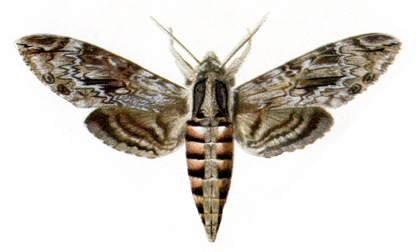
Agrius (ex Herse, Sphinx) convolvuli Linnaeus, 1758 [Sphingidae, Sphinginae]: a »hawk moth in tropical Africa, Asia, Australia and America that each year migrates over thousands of miles to temperate climates in Eurasia. It is a strong flyer, with a wingspan of 80–120 mm, and has an extremely long proboscis (up to 100 mm) to suck nectar from even the longest flowers like those of the tobacco plant. It has a "red black-belted body"; the wings are a very dark marbled gray. There is a white 'V' pointing outward on each of the forewing veins. The caterpillar (c. 60 mm long) lives on bindweed.
In his long nostalgic poem on the rapture of luring moths written in 1922, there comes "a black hawk-moth / with a pearl V on the knotty vein". This probably is a Convolvulus Hawk Moth.
The Convolvulus Hawk Moth is a likely candidate for the "party-crashing hawkmoths with red black-belted bellies" mentioned in Ada (p. 250).
*Ada 250; NabBut 107 (P); Lep1 33
& Ac: Ágrius/Hérse convólvuli • En: Convolvulus Hawk Moth, Unicorn • Fr: le sphinx du liseron • Ge: Windenschwärmer • It: sfinge del convolvolo • Ru: бражник вьюнковый • Sp: esfinge de la correhuela
Agrodiaetus Hübner, 1822: an abandoned genus of »Lycaenidae, subfamily Polyommatinae (blues). The type-species was »Agrodiaetus damon Denis & Schiffermüller, 1775, the Damon Blue. As a consequence of Bálint & Johnson's revisionary work (1997), most species of the genus were synonymized under Polyommatus Latreille, 1804.
Agrodiaetus ainsae: »Polyommatus ainsae
Agrodiaetus amandus: »Polyommatus icarius
Agrodiaetus damon: »Polyommatus damon
Agrodiaetus dolus: »Polyommatus dolus
Agrodiaetus escheri: »Polyommatus escheri
Agrodiaetus meledamon Rebel, 1920 [Lycaenidae]: what Rebel described under this name turned out to be a natural cross between the Damon Blue (»Polyommatus damon) and Meleager's Blue (»Polyommatus daphnis).
*Lep4 267
Agrodiaetus pheretes: »Albulina orbitulus
Agrodiaetus thersites: »Polyommatus thersites
Agrotis pilgrami Rebel: a moth dedicated to Pilgram, the "Aurelian" ("chrysalid lover") of the story. It is an invented species of the noctuid family. However, neither the genus nor Rebel are inventions. The genus is Agrotis Ochsenheimer, 1816 (ex Scotia), some species of which are nasty agricultural pests, and it is to be feared that Pilgram's insect will turn out to be one too. Dr. Hans »Rebel of Vienna (1861–1940) who allegedly named this insect in honor of Pilgram was one of the prominent turn-of-the-century lepidopterists, the editor of "Berge's Schmetterlingsbuch" and co-author of »Staudinger's commercial catalogue of Palearctic Lepidoptera. So Pilgram was honored by quite an authority of his time. Karges (1985) seems to assume that Nabokov intended to slight Pilgram and, disliking Freud, chose to do so by making another Viennese doctor the insect's godfather – an idea that seems singularly far-fetched.
*Stor:Aur 248
& Ac: Agrótis pílgrami • En: *Pilgram's Owlet • Ge: *Pilgrams Eule
Agrotis segetum Denis & Schiffermüller, 1775 [Noctuidae, Noctuinae]: one of Nabokov's cryptic lepidoptera. In Look at the Harlequins!, the narrator comes across an "ecologist's paper on the ravages committed by a bird of some sort, the Ozimaya Sovka ('Lesser Winter-Crop Owl'?)". Vadim being no entomologist, he does not know that the ozimaya sovka is not a bird but a moth, the Turnip Moth. The wingspan is 40 to 50 mm, the forewings are dark brown, the hindwings white in the males and grey in the females. It flies in Europe, most of Asia and in Africa south of the Sahara. The larvae feed on cultivated vegetables like turnips, red beet, potatoes, cereals, tobacco and vine, at night chewing the stems at ground level. When abundant, the Turnip Moth is considered a bad pest by horticulturists.
*LHarl 225
& Ac: Agrótis ségetum • En: Turnip Moth • Fr: la noctuelle des moissons • Ge: Saateule, Wintersaateule • It: nottua delle messi • Ru: Совка озимая • Sp: rosquilla gris
Albulina Tutt, 1909: a genus of »Lycaenidae, subfamily Polyommatinae (blues), tribe Polyommatini, »Polyommatus Section. The type-species is »Albulina orbitulus, the Alpine Argus.
*Lep8 124, 133; Lep9 40
Albulina felicis Oberthür, 1886 [Lycaenidae]: a blue in the E Himalayas (Tibet).
*Lep9 10, 27
Albulina (ex Vacciniina) optilete Knoch, 1781 [Lycaenidae]: a dark-blue Palearctic lycaenid with a wingspan of 22–25 mm, from C and N Europe to Japan. There also is a subspecies in Alaska. The preferred habitat is peat bogs.
& Ac: Albulína/Vacciniína optiléte • En: Cranberry Blue • Fr: l'azuré de canneberge • Ge: Hochmoorbläuling, Heidelbeerbläuling • Ru: голубянка Оптилете, торфяниковая толубянка *Lep8 104; Lep9 44
Albulina (ex Agrodiaetus) orbitulus de Prunner, 1798, syn pheretes Hoffmannsegg 1804 [Lycaenidae]: the Alpine Argus, a Eurasian blue in the C European Alps (mostly above 1,500 m), S Norway, Urals, the mountains of S Siberia and C China.
The "race of Agr. pheretes from the Swiss Alps" very probably is the 'aberration' maloyensis Rühl, 1895, the *Maloya Alpine Argus flying on the Maloya and Bernina passes in the canton Grisons.
*NabBut 336; Lep9 10, 27
Alcon: »Maculinea alcon
Alucita hexadactyla (Eckstein 1933)

Alucita Linnaeus, 1758: the type-genus of a family of Microlepidoptera, the Alucitidae. It is a small cosmopolitan family of about 100 species. They are unmistakable because the forewings are split up into six feathery fingers and the hindwings in six or more. When spread, the wings of many of them look exactly like an opened fan forming about two thirds of a circle. In Nabokov's long nostalgic poem on the joys of luring moths written in 1922, there comes "a tiny fan with a lucent fringe". This will have been an Alucita species, possibly Alucita hexadactyla Linnaeus, 1758, the Twenty-plume Moth, with six plus six partly translucent 'plumes' on each side and a wingspan of 12–14 mm; it flies in Britain and continental Europe, also in the NE.
*NabBut 107 (P)
Amandus Blue: »Polyommatus icarius
Amblyscirtes hegon Scudder, 1864, syn samoset Scudder, 1864 [Hesperiidae, Hesperiinae]: the Pepper-and-salt Skipper, a little black skipper (wingspan 20–22 mm), flying from SE Canada westward to Manitoba, Wisconsin and Iowa and southward to Georgia.
*NabBut 398 (L)
Amur Hawk Moth: »Laothoe amurensis
Anaea Hübner, 1819: a Neotropical genus of »Nymphalidae, subfamily Charaxinae (goatweeds). The type-species is Anaea troglodyta Fabricius, 1775, an autumn-leaf-like butterfly in Cuba, Jamaica, the Caribbean and C America.
*SelLet 103
Anarta cordigera (Lampert 1907)

Anarta cordigera Thunberg, 1788 [Noctuidae, Noctuinae]: an owlet moth with a wingspan of 20–25 mm, typical of the tundra, but also in Europe, Asia and N America where the microclimate is tundra-like. It has a bright yellow zone on the hindwings. "Pretty Cordigera, a gemlike moth …"
*SpeakM 138
& Ac: Anárta cordígera • En: Common Yellow Underwing, Small Dark Yellow Underwing, (Nabokov) Cordigera • Fr: (Autres rivages) l'Anarta Cordigera • Ge: Moorbunteule, Sumpfheidelbeerbunteule • Ru: совка пёстрая торфянниковая
Ancyloxypha numitor Fabricius, 1793 [Hesperiidae, Hesperiinae]: the Least Skipperling, common from Nova Scotia and Quebec south to Florida and westward to Saskatchewan and Texas. The wingspread is 19–25 mm.
*NabBut 398 (L)
The Orange Moth, Angerona prunaria (Berge 1899)

Angerona prunaria Linnaeus, 1758 [Geometridae, Ennominae]: a geometer moth with a wingspan of 35–45 mm in all of temperate Europe and Asia. It is a very variable species. Some of its male forms are downright orange, others show orange marks interspersed with brown.
*SpeakM 129
& Ac: Angeróna prunária • En: Orange Moth, Orange Thorn • Fr: le phalène du prunier, (Autres ravages) Phalène Orange • Ge: Schlehenspanner • It: geòmetra della ginestra • Ru: пяденица сливовая • Sp: naranja
Polygonia c-album (Lampert 1907)
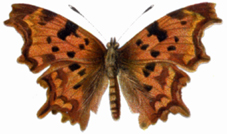
anglewing (butterfly): if not used in a broader sense, this is a butterfly of the Holarctic genus Polygonia Hübner, 1819 [Nymphalidae, Nymphalinae, Nymphalini], characterized by very ragged wing margins.
& Ac: Polygónia • En: anglewing, angle-wing, angle wing, Angle-wing, Angle-wing • Ge: Zackenfalter
The one in The Gift, seen in the Grunewald of Berlin, has wings of a "yellow-brown silk" and a "white bracket on its dark mottled underside". Hence it must be the Comma Butterfly, Polygonia c-album Linnaeus, 1758, with the white C of its name on the underside of the hindwings and not to be confused with »Hesperia comma Linnaeus, 1758, which is a skipper. It used to be quite frequent in W Europe from the Mediterranean region to as far north as the 66th parallel but seems to be on the decline (see »Admirable Anglewing).
*Gift 332
& Ac: Polygónia c-álbum • En: Comma Butterfly • Fr: le Robert le diable • Ge: C-Falter, C-Fuchs • It: poligonia-C, vanessa c-bianco • Ru: углокрыльница цэ-белое • Sp: C-blanca
The American one from the Oak Creek Canyon "has a curiously formed letter C. It mimics a chink of light through a dead leaf. Isn't that wonderful? Isn't that humorous?" This must be »Polygonia silvius W.H. Edwards, 1874.
& Ac: Polygónia sílvius • Am: Sylvan Anglewing
Butterflies and moths are prey to a host of predators – birds, snakes, lizards, flies, spiders, butterfly hunters and many others. One of the many protective strategies they have adopted is crypsis or camouflage. When resting, many adult species fuse with the background, looking like a piece of rock or a stretch of bark. Others resemble leaves in form and color. Some, by their way of moving, even resemble falling autumn leaves. The yellow color of the Brimstone [»Gonepteryx rhamni] which overwinters on the ground among rotting leaves and other debris probably is supposed to make it look like an innocent withered leaf. The most leaf-like butterflies, however, are a number of Asian butterflies, some members of the Neotropical genus Anaea Hübner, 1819 [Nymphalidae], and more or less all the Holarctic »tortoiseshells with their mottled undersides. In Speak, Memory (p. 125), Nabokov writes: "When a butterfly has to look like a leaf, not only are all the details of a leaf beautifully rendered but markings mimicking grub-bored holes are generously thrown in." This probably refers to the anglewing butterflies with their wildly ragged margins which make them look like brown leaves at which caterpillars have been gnawing. The impression of boreholes etc. is much more marked in the dry-leaf butterflies of the genus »Kallima Doubleday, 1849.
*Gift 332; Stor:MlleO 482; SpeakM 125; Int1 129 (NabBut 534)
Antheraea polyphemus Cramer, 1776 [Saturniidae]: a common and big N American emperor moth with two very distinctive eyespots.
*P&P 171; N/WLet #257= 213old, mentioned by Wilson
& Ac: Antheráea polyphémus • Am: Polyphemus Moth • Ge: *Polyphemus-Nachtpfauenauge
Anthocharis (ex Euchloe) belia Linnaeus, 1767 [Pieridae, Pierinae]: the Moroccan Orange-tip and two of its subspecies, in Morocco, Algeria and on the Iberian Peninsula.
*Lep2 256, 257
& Ac: Anthócharis/Euchlóë bélia • En: Morocco Orange Tip • Fr: l'aurore de Provence • Ge: Gelber Aurorafalter
Anthocharis cardamines (Hübner 1793-1827)
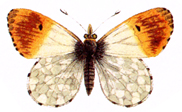
Anthocharis (ex Euchloe) cardamines Linnaeus, 1758 [Pieridae, Pierinae]: the European Orange-tip par excellence, a pierid with a wingspan of 35–45 mm. The females lack the orange forewing tips of the males and are marked black instead. It flies from late March to June on damp meadows as well as on alpine grassland and dry lowland scrub from W Europe and the Middle East across temperate Asia to Japan.
*SpeakM 62; Lep1 31; Lep2 257, 268
& Ac: Anthócharis/Euchlóë cardámines • En: Orange-tip, Wood Lady • Fr: l'aurore • Ge: Aurorafalter • It: aurora • Ru: зорька (сердечниковая), петрушечница, аврора • Sp: musgosa
Anthocharis (ex Euchloë) euphenoides Staudinger, 1869 [Pieridae, Pierinae]: a common Spanish Orange-tip today considered a subspecies of Anthocharis belia.
*Lep2 268, 270
Anthocharis gruneri Herrich-Schäffer, 1851 [Pieridae, Pierinae]: a white butterfly whose forewings have orange tips bordered by two dark bands. Its wingspan of about 30 mm makes it smaller than »Anthocaris cardamines, the Orange-tip of W Europe. Its range is from SE Serbia and mountains in Greece across Turkey and Asia Minor to Armenia.
*SpeakM 253
& Ac: Anthócharis grúneri • En: Gruner's Orange-tip • Fr: l'aurore des Balkans • Ge: *Gruners Aurorafalter
Antocharis ada Krolik, 1884: an invented butterfly of the pierid family dedicated to Ada by her nature teacher. It is an Orange-tip "above timberline, in another hemisphere" (that is, in Europe). Its name was changed to Antocharis prittwitzi Stümper 1883 "by the inexorable law of taxonomic priority". A man called Stümper obviously had described the same insect just a year before Krolik, and in accordance with the taxonomic Law of Priority, Krolik's name (ada) was what taxonomists call a junior synonym and had been invalid from the beginning. 'Stümper' by the way is German and means 'bungler'. Stümper's specific name though (prittwitzi) is not altogether an invention. There was a lepidopterist by the name of »Prittwitz.
In a tv interview with Bernard Pivot (Int14), Nabokov said about the butterflies of Ada: "A l'exception de quelques papillons suisses dans Ada, j'ai inventé les expèces mais non les genres – c'est le gentil detail –, et je soutiens que c'est la première fois qu'on a inventé des papillons scientifiquement possible. On pourrait très bien répondre: 'En satisfaisant le savant, vous profitez un peu de l'ignorance du lecteur, en fait de papillons,' car si vous aviez inventé un type de chat ou de chien pour les châtelains du livre, la supercherie aurait seulement irrité le lecteur qui devrait imaginer chaque fois un petit quadrupède assez mythologique chacque fois qu'Ada prend l'animal dans ses bras.'"
*Ada 57
Apatura Fabricius, 1807: a very distinct genus of Nymphalidae, subfamily Apaturinae (emperors). The type-species is »Apatura iris Linnaeus, 1758. What is particular about them is that their wings are iridescent and take on different colors if looked at from different angles. The iridescence is produced by tiny air chambers in the scales. In illustrations the effect is usually rendered by giving both sides a different color. Once dead, the emperors lose their iridescence so museum specimens give only an unsufficient idea of what these large und stately butterflies look like on the wing.
*NabBut 207 (FB), 575 (BE)
& Ac: Apatúra • En: Purple Emperors • Fr: mars changeants • Ge: Schillerfalter • Ru: (DarII) апатуры
Apatura iris (Lampert 1907)
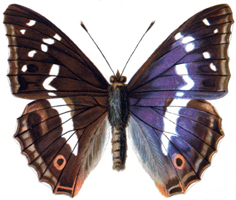
Apatura iris Linnaeus, 1758 [Nymphalidae]: a large nymphalid (wingspan 55–65 mm), dark brown with white marks on the forewings and a white band on the hindwings. In the males the wings have an iridescent purple, violet or bluish lustre. It flies in forested regions from England and the N of Spain across C Europe and Asia to Japan.
Hunting for it with interviewer Alan Levy (Int11) in 1971 in the vicinity of Montreux, this one reports, "After calling for 'silence, not total silence, but some silence,' he describes 'its beautiful violet sheen – if you turn it this way and that way, the shimmer changes. It used to fly here until they asphalted the road. Now it's getting scarcer and scarcer. I saw one the other day up in Caux, but I couldn't look at it closer because it was flying higher and higher in such a hurry—Ahhh!'… He admits he was seeking it for sentimental reasons: "I just remember many places with it. As a boy, I hunted it in Bad Kissingen, in Bavaria."
In "Father's Butterflies", Nabokov has Godunov Senior remark on the difficulty of picturing the iridescence of the Purple Emperor's Wings. "Many black-colored diurnal butterflies, when very fresh, have a striking metallic or moiré, blue-green sheen, which does not survive in prepared specimens; nonetheless, illustrators have succeeded not only in making the wings of the iridescent Apaturas iridesce with a warm ('rich') violet cast depending on how the page angled toward the light (so that the right or the left half of the Apatura displays its August 'purple'), but certain black satyrids as well, when struck by light, suddenly glow with the gloss of green inks and thus the master's portrait expresses the essence of the butterfly better than the specimen itself in the collection" (Nabokov's Butterflies, p. 207).
In a letter to Wilson, Nabokov says that the entomological part in Gerald Heard's otherwise enjoyable detective novel Taste for Honey is all wrong, citing as an example the confusion of the Purple Emperor with »Saturnia pavonia, the Emperor Moth.
(An American nymphalid is also called Purple Emperor or Pavon: Doxocopa pavon Latreille 1805, in S Texas, Mexico, Panama and Bolivia.)
In The Gift, there is "a huge butterfly, flat in flight, bluish-black with a white band". That could be a Purple Emperor but probably is a Poplar Admiral (»Limenitis populi).
Brian Boyd believes the Purple Emperor may also be cryptically present in Pale Fire (personal communication): "Charles II takes the tunnel toward what had been Iris Acht's dressing room. He doesn't know where he's headed, but we're invited to guess … He is in bright red garb, the Red King; I think there is a not accidental relationship between the Purple Emperor, Apatura iris, and the attire he finds himself in". In his Nabokov's Pale Fire, Boyd concludes: "Hazel [Shade], in her role as butterfly, as Red Amirable (or more commonly, Red Admiral), seems to stand behind the [dead actress] Iris [Acht] who offers Kinbote his escape as red king or Purple Emperor" (p. 160).
*Gift 78; SpeakM 133; possibly PaleF 134; EugOn 2.521; Int11; N/WLet #76=64old; NabBut 207 (FB)
& Ac: Apatúra íris • En: Purple Emperor • Fr: le grand mars changeant • Ge: Großer Schillerfalter • It: apatura iride • Ru: переливница Ирида • Sp: tornasolada
& Apatúra ília: En: Lesser Purple Emperor • Fr: le petit mars • Ge: Kleiner Schillerfalter • Ru: переливница Илия • Sp: tornasolada chica
Aphantopus Wallengren, 1853: a small genus of »Nymphalidae, subfamily Satyrinae, tribe Maniolini (US wood nymphs and satyrs, GB meadow browns and ringlets). The type-species is »Aphantopus hyperantus, The Ringlet.
Aphantopus hyperantus (Lampert 1907)
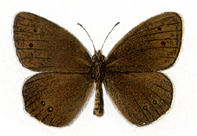
Aphantopus hyperantus Linnaeus, 1758 [Nymphalidae, Satyrinae]: a dark brown satyrine with a wingspan of 35–42 mm and a distinctive yellow-ringed eyespot near the rim of the hindwings. It is one of the most frequent butterflies on the meadows and in the light woodlands of C and N Europe and Asia, lacking around the Mediterranean. "In central Europe it prefers shady lanes and the outskirts of woods but in North Russia it is a typical denizen of open fields where it occurs in countless numbers".
*Gift 133; NabBut 589–90 (BE); Lep2 270
& Ac: Aphántopus hyperántus • Am: Ringlet Wood-nymph • En: The Ringlet, (Nabokov) Aphantopus Ringlet • Fr: le tristan, (Don) "tristan chocolat • Ge: Brauner Waldvogel, Schornsteinfeger • It: tristano ² Ru: глазок цветочный, бархатница Гиперант • Sp: sortijitas
Aphantopus Ringlet: Nabokov's name for »Aphantopus hyperantus
Apodemia mormo C. & R. Felder, 1859 [Lycaenidae, Riodininae]: the Mormon Metalmark, along the American W Coast and the Rocky Mountains to Mexico.
*StrOps 327; Lep16
apollo butterflies, apollos: several species of the genus »Parnassius Latreille, 1804 [Papilionidae].
*Stor:Aur 250; Gift 117–118
Aporia Hübner, 1819: a genus of »Pieridae, subfamily Pierinae (whites). The type-species is »Aporia crataegi, the Black-veined White. Nabokov considered Aporia a subgenus of SE Asian »Delias Hübner, 1819.
*NabBut 587 (BE)
Aporia crataegi (Lampert 1907)
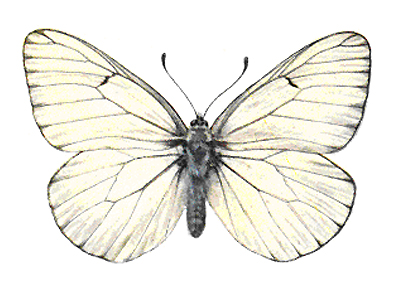
Aporia crataegi Linnaeus, 1758 [Pieridae]: a rather large white (wingspan 50 to 65 mm) distinguished by its sharp dark veins. From N Africa and W Europe (except Britain and N Fennoscandia) across Asia to Korea and Japan.
In "Father's Butterflies", Nabokov wrote about a crowd of them that their "general appearance was reminiscent either of little paper cockerels or a regatta of sailboats heeling this way and that."
"The blood drops noticed by ancient historians on the white walls of doomed cities …"
In one of the letters to Véra, Nabokov mentions the "wonderful" Aporia crataegi augusta TURATI, 1905, a subspecies or a form Eurilio Turati had found in Sicily.
*Gift 133; NabBut 211 (FB), 587 (BE); Lep1 30; Lep2 270; LtVé 51
& Ac: Apória cratáegi • En: Black-veined White • Fr: le gazé, (Don) "gazé veiné de noir" • Ge: Baumweißling, Heckenweißling • It: pieride del biancospino • Ru: белянка боярышниковая, (DarII) боярышница • Sp: blanca del majuelo
arborea: »Phyllodesma japonica arborea
Araschnia levana (Lampert 1907)

Araschnia levana Linnaeus, 1758 [Nymphalidae, Nymphalinae, Nymphalini]: the only European representative of the SE Asian genus Araschnia Hübner, 1819. The range is N Spain, C and E Europe, Caucasus, C Asia to NE China, Korea and Japan. The wingspan is 32–40 mm. Below, the wings have a network of narrow white lines resembling that give it the appearance of a map. The butterfly is seasonally dimorphic. There are two broods. The spring form (Araschnia levana f. levana) is dusky-orange with black markings, the summer form (Araschnia levana f. prorsa) is maroon.
"Not generally realized what a strong migrant this is. Hibernates in the chrysalid stage as far north as Leningrad. One day in the Spandau Forest (Berlin), in late July 1934 or 1935, I observed a swarm of exhausted levanas, of the summer form, resting on flowers and shrubs".
*NabBut 597 (BE)
& Ac: Aráschnia levána • En: Map Butterfly • Fr: la carte géographique • Ge: Landkärtchen • It: carta geografica gialla • Ru: пестрокрыльница Левана • Sp: prótea
Archon apollonius Herbst, 1798 [Papilionidae, Parnassiinae]: the False Apollo, in S Balkans, Turkey, Near and Middle East. It is closer to the genus »Zerynthia (the Festoons) than to »Parnassius (the apollos), but less gaudily patterned. "This butterfly looks like a Parnassius in fancy dress."
*NabBut 583 (BE)
Arctia caja (Hofmann 1894)
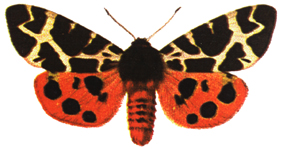
Arctia Schrank, 1802: a genus of »Arctiidae, subfamily Arctiinae. The type-species is the well-known Holarctic Arctia caja Linnaeus, 1758, in all of Europe, Russia, Asia Minor, Iran, Mongolia, Himalayas, (less frequently) N America, up to an altitude of 2,000 m. The wingspan is 45–80 mm, the forewings are white mottled with brown, the hindwings orange-red with black dots. The pattern is so variable that hardly two specimens ever are quite alike. To predators, it is noxious; hence its aposematic (warning) coloring.
*NabBut 211 (FB)
& Ac: Árctia cája • Am: Great Tiger • En: Garden Tiger • Fr: l'écaille-martre • Ge: Brauner Bär • It: arctia orso bruno, caia • Ru: медведица пылающая • Sp: arctia gitana
Arctia festiva ex hebe (Procházka 1966)

Arctia hebe LINNAEUS, 1758 [Noctuidae, Arctiinae], obsolete synonym of Arctia festiva HUFNAGEL, 1766. Sometimes it is ranged into a separate monotypic genus, Eucharia. Arctia festiva is a strikingly colored tiger moth (yellow, red, black) with a wingspan of 45-60 mm. On sandy terrain in Central and Southern Europe, European Russia, Central Asia, Southern Siberia, Mongolia and China.
& Ac: Árctia hébe, Árctia féstiva • En: Hebe Tiger Moth • Ge: Englischer Bär • Fr: Écaille rose, Écaille hébé • Ru: Медведица геба
*LtVé 51, 97
Arctia virgo: see under »Grammia virgo
Arctic Fritillary: »Clossiana chariclea
Arctiidae Leach, 1815: a family of moths, comprising about 8,000 species, many of them in S America. Most of them but not all are nocturnal. They are medium to large and furry. Their name derives from the Greek word arktos, bear, and is an allusion to their furry appearance. Some authors today consider the Arctiidae to be a subfamily of Noctuidae, Arctiinae.
& Ac: Arctíidae • En: arctiids, tiger moths • Fr: arctidés, écailles • Ge: Bärenspinner • It: arctidi • Ru: медведицы, (DarII) арктии • Sp: árctidos
argulus: »Plebejus idas argulus
Plebejus argus m (Sepp 1762)

Argus: actually a dark blue car Van, in Ada, is driving to Mont Roux. The color probably is that of the blue »Plebejus argus. To Van, it is "dearer than sapphires and morphos". Morphos, of course, are those striking S American butterflies, many of them blue (»Morpho); sapphires could be just that, but probably they are the nymphalid species »Asterope sapphira. In his Argus, Van stops at 'Sorcière,' where he owns a house called 'Villa Jolana,' now empty (Ada 552). This is a reference to »Iolana iolas, another blue lycaenid also mentioned in Ada (p. 128). In Pale Fire, an anagrammatic alias of the killer Gradus is 'Jacques d'Argus'.
*PaleF eg 273, 307; Ada 551, 558; Lep2 270
& Ac: Plebéjus árgus • En: Silver-studded Blue • Fr: l'azuré de l'ajonc • Ge: Geißkleebläuling • Ru: голубянка Аргчс • Sp: niña hocecillas
Argynnini Blanchard, 1840: a tribe of the subfamily Heliconiinae in the family »Nymphalidae. In America, Argynnini are usually equated with the group colloquially known as fritillaries.
*NabBut 300
& Ac: Argynníni • Am/En: fritillaries • Fr: nacrés • Ge: Perlmutterfalter • Ru: перламутровки • Sp: nacaradas
argynninarium: Ada's and Dr. Krolik's invention, a "pestproof breeding house" for the larvae of greater and lesser »fritillaries. Formerly most fritillaries were considered to belong to one genus only, Argynnis Fabricius, 1807; whence the name.
*Ada 404
Argynnis Fabricius, 1807: a genus of »Nymphalidae, subfamily Heliconiinae, tribe Argynnini (fritillaries). The type-species is »Argynnis paphia, the Silver-washed Fritillary.
Argynnis adippe: »Fabriciana adippe
Argynnis aglaja: »Speyeria aglaja
Argynnis cydippe: »Fabriciana adippe
Argynnis elisa Godart, 1823 [Nymphalidae]: the Corsican Fritillary, restricted to Corsica and Sardinia, at altitudes of 500–1,500 m.
*NabBut 596 (BE)
Argynnis laodice: »Argyronome laodice
Argynnis niobe: »Fabriciana niobe
Argynnis pandora: »Pandoriana pandora
Argynnis paphia (Lampert 1907)
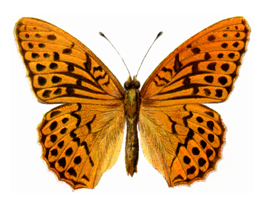
Argynnis (ex Dryas) paphia Linnaeus, 1758 [Nymphalidae]: the type-species of the genus Argynnis Fabricius, 1807, this is a rather large fritillary with a wingspan of 55–65 mm, at one time one of the commonest butterflies of Europe, now on the decline. Its range is N Africa across Europe and temperate Asia to Japan. The upperside of its wings is bright orange with scattered black dots and dashes. The underside of the hindwings is mainly greenish, with silvery white stripes and borders; hence its English vernacular name.
In the form valesina Esper 1798, the females are much darker and suffused greenish gray. It is the common one in Europe but unknown in N Africa and Sardinia. "One afternoon [near a famous resort on the Baltic coast, in the vicinity of St. Petersburg], as in concentrated ecstasy I was spreading, underside up, an exceptionally rare aberration of the Paphia Fritillary, in which the silver stripes ornamenting the lower surface of its hindwings had fused into an even expanse of metallic gloss …" (Pnin, p. 177)
'Paphia' is the name of the owner of a beauty parlor in Mont Roux that Ada frequents.
*Pnin 177; Ada 528; NabBut 207 (FB); Lep1 31
& Ac: Argýnnis páphia (valésina) • En: Silver-washed Fritillary, (Pnin) Paphia Fritillary • Fr: le tabac d'Espagne • Ge: Kaisermantel, Silberstrich • It: mantello dell'imperatore, pafia • Ru: перламутровка Пафия, перламутровка большая лесная, обыкновенный карпоед, (DarII) пафия • Sp: nacarada
Argyronome (ex Argynnis) laodice Pallas, 1771 [Nymphalidae, Heliconiinae, Argynnini]: Pallas's Fritillary, in CE Europe, C and S Urals, S and W Siberia, NW Kazakhstan, Amur region, Japan. "Strays N. to the Gulf of Finland".
*NabBut 601 (BE), 611 (BE)
Aricia Reichenbach, 1817: a genus of »Lycaenidae, subfamily Polyommatinae (blues), tribe Polyommatini, »Polyommatus Section The type-species is »Aricia agestis. In 1997, the genus »Icaricia Nabokov, 1945 has been included in Aricia.
*NabBut 340
Aricia (ex Lycaena) agestis Denis & Schiffermüller, 1775, syn medon Hufnagel, 1776, astrarche Bergsträsser, 1779 [Lycaenidae]: a blue in N Africa, C and S Europe, Turkey, Middle East, Iran, Tianshan, Siberia, Amur region.
*NabBut 577 (BE); Lep2 268, 269; Lep8 104; Lep9 15, 40, 47
& Ac: Arícia agéstis • En: Brown Argus • Fr: le collier de corail • Ge: Kleiner Sonnenröschenbläuling • Ru: голубянка Агестис
Aricia allous sarmatis Grum-Grzhimaylo, 1890, syn inhonora Jachontov, 1909 [Lycaenidae]: a blue described from the Ural region and occurring in C and S Russia. Some authors have considered the name a synonym of »Aricia agestis.
*Lep1 30
Aricia anteros Freyer, 1838 [Lycaenidae]: the Blue Argus of the Balkans, Asia Minor, Iran.
*Lep8 105
Aricia artaxerxes Fabricius, 1793 [Lycaenidae]: the Mountain Argus, in Morocco, Spain, Scotland and N England, Fennoscandia, SE Europe, Turkey and eastwards to Altai Mountains. The alleged subspecies debrosi Beuret, 1930 is a synonym of Aricia artaxerxes semimontensis Verity, 1928, a Mountain Argus described from Andalusia.
*NabBut 609 (BE)
Aricia donzelii: »Aricia nicias
Aricia (ex Icaricia) icarioides Boisduval, 1852 [Lycaenidae]: the Icarioides Blue, described from the "mountains of California", occurring in isolated colonies west of the Great Plains from Alaska to Baja California, from sea level to 4,000 m. It is so variable that Howe (1975) lists the twelve subspecies that have been described only reluctantly, as "the differences one observes between populations may be real, but they may also be a reflection of the environmental features of a given area" (p. 344). In a draft letter, Nabokov wrote in late 1943–1944, "The species is quite obviously in a state of furious evolution and one almost feels that one would like it to 'settle down' before naming races."
According to Nabokov, the Icarioides Blue is the N American member of the »Plebejinae subfamily with the longest male intromittant organ.
In Ada (p. 94), a "silver-and-sable skybab squirrel sat sampling a cone on the back of a bench". As Nabokov pointed out to McGraw-Hill editor Anthony Velie (January 20, 1969), "Skybab squirrels are Kaibab squirrels". Brian Boyd explains: "Invented subspecies of squirrel, reflecting Nabokov's own discovery of the Kaibab race of the Blue butterfly Icaricia icarioides, of which he caught a series in July 1956 on the Kaibab Plateau, on the North Rim of the Grand Canyon" ("Annotations to Ada, 15: Part 1 Chapter 15", The Nabokovian, 44, Spring 2000, p. 67). Among the twelve subspecies of the Icarioides Blue, there is none called kaibabensis. The Kaibab Squirrel, on the other hand, is not Nabokov's invention but very real. It is Sciurus aberti kaibabensis, a tree squirrel living in the ponderosa pines of Kaibab National Forest on the North Rim of the Grand Canyon. On the South Rim, there is the very similar Sciurus aberti, the Tassle-eared Squirrel (or Abert's Squirrel). It is assumed that the chasm of the Grand Canyon has split the common ancestral population, and Creationists have used the small differences between the two to "prove" that the Grand Canyon originated only a few thousand years ago. Actually, the Colorado River began to cut the Grand Canyon about six million years ago. 'Kaibab' incidentally is a Paiute word meaning 'mountain lying down.'
*NabBut 297; Lep9 27; Lep14 499
Aricia idas: »Aricia morronensis
Aricia isaurica Staudinger, 1871 [Lycaenidae]: a blue in the Middle East (Kurdistan and Levant).
*Lep9 27
Aricia morronensis Ribbe, 1910, syn idas Rambur, 1840 [Lycaenidae]: the Spanish Argus, very sporadic in Spain and the Pyrenees.
*Lep9 35
Aricia neurona Skinner, 1902 [Lycaenidae]: the Veined Blue, in small colonies at high altitudes in S California and the S Sierra Nevada. "I want to revisit emigdionis, neurona".
*NabBut 516 (L)
Aricia nicias Meigen, 1829, syn donzelii Boisduval, 1832 [Lycaenidae]: the Silvery Argus, a blue in the Pyrenees, the Alps, S Siberia and Mongolia.
*Lep9 4
Aricia psylorita: »Polyommatus psylorita
Aricia shasta (Howe 1975)

Aricia (ex Icaricia) shasta W.H. Edwards, 1862 [Lycaenidae]: a N American blue with a wingspan of 22–25 mm, at home mostly in the high mountains (up to almost 4,000 m) of Oregon, California, the Great Basin and Colorado. It is named for Mt. Shasta in California.
*StrOps 326; SelLet 199; NabBut 498 (L); Lep14 499
& Ac: Arícia/Icarícia shásta • Am: Shasta Blue, Cushion-plant Blue
Aricia (ex Icaricia) shasta minnehaha Scudder, 1874 [Lycaenidae]: the Minnehaha Blue, a subspecies of the Shasta Blue, at home in most of its range, with a narrower border of the upper forewings.
*StrOps 326
Aricia (ex Icaricia) shasta shasta W.H. Edwards, 1862, syn f. comstocki Fox, 1924 [Lycaenidae]: a local form of the Shasta Blue, in Yosemite Nat'l Park. This was the first to be described and thus became the nominal subspecies.
*SelLet 199; NabBut 519 (L)
Arlequinus arlequinus: an angular imaginary butterfly (male) with harlequin patterned wings which Nabokov drew in August 1974 on Véra's copy of Look at the Harlequins!, reproduced in Boyd VNAY, 2 pages before 563. »Harlequin.
Arran Brown: »Erebia ligea
Aspen Hawk (Moth): »Laothoe amurensis
*Asterope (ex Callithea) sapphira Hübner, 1816 [Nymphalidae]: Van in Ada has a car, "a dark-blue Argus, dearer to him than sapphires and morphos". Though the sapphires could just be sapphires, the presence of the other two butterflies in the sentence (»Plebejus argus, »Morpho) makes it likely that they too are butterflies. Obligingly the males of Asterope sapphira are dark blue and black. The wingspan is c. 50 mm, and they fly where Morphos also fly, on the Lower Amazons.
*Ada 551
Ateleomorpha Warren, 1926: an abandoned genus of »Hesperiidae (skippers), Pyrginae (pyrgine skippers). The type-species was »Pyrgus onopordi Rambur, 1840, the Rosy Grizzled Skipper, in Morocco, Algeria, SW Europe.
*NabBut 577 (BE)
Atlantis: »Speyeria atlantis
Atlas White: Nabokov is referring either Pieris napi atlantis Oberthür, 1923, a local and uncommon white of the Middle Atlas, or to Pieris napi segonzaci le Cerf, 1923, of the High Atlas [Pieridae].
*StrOps 334
Atramentaria: This is not the name of a genus. In B.C.S. Warren's Monograph of the Genus Erebia (London 1936), there is one informal group of Erebia species called 'Atramentaria'. It consists of one sole species, the Chinese Erebia atramentaria Bang-Haas, 1927. Nabokov probably listed this group and the next one (the S Asian Callerebia) only to make his table of Palearctic Erebia species complete, for neither Erebia atramentaria nor any Callerebia species occur in Europe and would have figured in his book on European butterflies.
*NabBut 591 (BE)
Attacus Moth: »Attacus atlas
Attacus atlas (Procházka 1966)
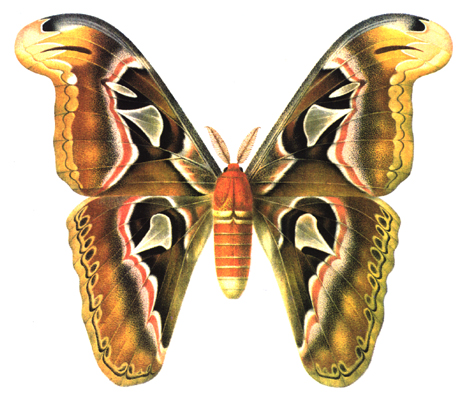
Attacus atlas Linnaeus, 1758 [Saturniidae]: this is the insect which Sleptsov witnesses breaking its cocoon. It is one the largest Lepidoptera in the world, with a wingspan of up to 240 mm (see also under »Troides). Its wings are patterned in many shades of brown, with a translucent triangular patch on each wing. The wingtips are strongly curved, forming a "Snake's Head" and earning the moth the name 'Cobra' in Italy. It also might be the most short-lived of moths. The adult is not equipped for eating at all and lives only as long as the fat reserves last that its huge green caterpillar (up to 120 mm long, up to 20 mm in diameter) has amassed – which is around twelve days. Its range is India and all of tropical SE Asia, up to China.
The exhibition of Nabokov's Lepidoptera at the Museo di Storia Naturale in Milano (1992) offered an alternative: Archaeoattacus edwardsi(i) White, 1859. This is a close relative, but with a wingspan of up to 240 mm not quite as huge as atlas and more distinctly marked, with rich browns, magentas and tans. Its range is much smaller than that of atlas. In fact, it is restricted to moist and inaccessible valleys of the Himalayas. Thus it is not likely to be found fluttering "birdlike, around lamps in the Indian dusk". For this reason, and for reasons of size, I think it is atlas rather than edwardsi what Nabokov here had in mind. The caterpillars of both moths, however, are great favorites with breeders.
"The enormous moth which in a state of repose assumes the image of a snake looking at you" of The Gift (p. 110) might be Attacus atlas whose curved wingtips, when at rest, form what resembles a snake's head in profile. Another likely candidate is the similar Rhescyntis hippodamia Cramer, 1777, an emperor moth in Surinam and Brazil with a wingspan of up to 210 mm. Somewhat smaller is the »South American Silkmoth which also seems to employ the snake scare. However, whether the wingtips of these large moths are to fool predators into thinking they have a snake before them is doubtful. The pseudo-snakes formed by wingtips are not looking directly at the prey but sideways. There are thousands of butterflies and moths with impressive eyespots, but these as such do not have anything particularly snakelike about them but rather seem to signify 'eyes' in general, especially the eyes of big birds of prey. If particular eyes are imitated, it is the eyes of owl-like birds. In some moths of the genus »Caligo Hübner, 1819, the owl look is so pronounced that they are called 'Owls' in popular parlance. There are a number of caterpillars that clearly employ the snake scare, notably that of »Deilephila elpenor and »Papilio troilus.
*Stor:Xmas 134, 136; perhaps Gift 110
& Ac: Áttacus átlas • En: Atlas Moth, Giant Atlas Silkmoth • Fr: l'atlas • Ge: Atlasspinner • It: cobra • Ru: павлиноглазка атлас
& Ac: Áttacus edwárdsi • En: Edwards' Moth • Fr: l'atlas d'Edwards • Ge: Edwards' Atlasspinner
Augiades comma: »Hesperia comma
Augiades sylvanus: »Ochlodes faunus
aurelia: »Mellicta aurelia
Dedication plate from The Aurelian (1766), showing two Swallowtails and their caterpillars and chrysalides

Aurelian: an old English word for a collector and breeder of butterflies and moths, from NL aurelia 'golden in color', analogous to chrysalis, another word for the pupa of a butterfly. In Greek, chrysos signifies 'gold'. Some butterfly pupae have a golden sheen. The word 'Aurelian' was coined by the English entomologist and engraver Moses Harris (1731-1785) who in 1766 published what was to become the most famous and most beloved of 18th century butterfly books. The title was The Aurelian, a natural history of English insects.
Austautia simonoides n.sp.: an invented species in The Gift, supposedly discovered by Fyodor's father in 1916, "a geometrid moth mimicking a small Parnassius". Its genus is an imaginary one, but it is named after a real person, the Geneva entomologist Jules Léon Austaut (1844–1929). Austaut was an expert on the genus »Parnassius and published a monograph on its members (Les Parnassiens de la faune paléarctique, Leipzig, 1889). One of the parnassians it features is Parnassius simo Gray, 1853, a rare butterfly described from the SE Himalayas, near Ladakh. Parnassius simo is quite small as parnassians go, with a wingspan of about 50 mm. It is so exceedingly rare that Austaut admitted never having seen a specimen of it. What he had seen was a subspecies the Dresden butterfly dealer Otto »Staudinger had received, named and sent on to him: Parnassius simo simonius Staudinger, 1889. Some twenty-two years later, Austaut himself described another subspecies, Parnassius simo simonides Austaut, 1911 (Internationale entomologische Zeitschrift [Guben], 5, 1911, p. 360). There also are Parnassius simo simoides Bang-Haas, 1927 and Parnassius simo simulator Staudinger, 1889, truly a confusing gang, with a lot of simulation going on while there was no simo. Nabokov was not enthusiastic about describing new subspecies on the strength of very few specimens from one locality. On this basis, there really is no telling which is the taxonomic relation between the different forms. The name of the invented moth mimics the practice of calling these doubtful new taxa sim- something.
If the invented geometer moth mimics a parnassian, it must be another case of mimicry across family borders. There are some geometrids that approach Parnassius simo in size, but none can be said to resemble it. A (Batesian) mimicry of this kind would be absurd and is probably meant to be so (that's the joke, perhaps prompted by Staudinger's simulator). While it is true that some parnassians are poisonous and imitating them might afford protection to other insects, this would be worthwhile only if there were enough models around so interested predators had a chance to learn that they taste nauseous and make one feel sick and are better avoided. If the "small Parnassian" is akin to Parnassius simo, however, it is one of the rarest of all butterflies and will be living in some remote valley of the Himalayas. Imitating it would be like advertising "you have not seen one like me before, so sample me".
It may be irony on Nabokov's part to have a fan of parnassians honored by having a genus of absurd geometer moths named for him. In reality, there was an Algerian geometrid species named for Austaut, Petrophora (ex Lithina) austautaria Oberthür. There also is a hawk moth called Laothoe austauti Staudinger, 1877 and a satyrine by the name of Coenonympha dorus austauti Oberthür, 1881, Austaut's Algerian Heath. Both are from N Africa.
*Gift 103
Autographa bractea (Hofmann 1894)
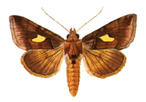
Autographa (ex Plusia) bractea Denis & Schiffermüller, 1775 [Noctuidae, Plusiinae]: a Palearctic owlet moth marked with a leaf-like silver or golden spot on the brown forewings, ranging from England across Europe and Asia to Japan. The wingspan is 27–42 mm.
*SpeakM 134
& Ac: Autógrapha/Plúsia bráctea • En: Gold Spangle • Fr: la feuille d'or • Ge: Braune Silberfleckhöckereule, Silberblatt • Ru: металловидка золоченая
Autographa (ex Phytometra, Plusia) excelsa Kretschmar, 1862 [Noctuidae, Plusiinae]: As a boy in Vyra, Nabokov took "a beautiful Plusia (now Phytometra) which, as I saw at once, differed from its closest ally by its mauve-and-maroon (instead of golden-brown) forewings, and narrower bractea mark and was not recognizably figured in any of my books. I sent its description and picture to Richard South, for publication in The Entomologist. He did not know it either, but with the utmost kindness checked it in the British Museum collection – and found it had been described long ago by as Plusia excelsa by Kretschmar. I received the sad news … with the utmost stoicism; but many years later, by a pretty fluke (I know I should not point out these plums to people), I got even with the first discoverer of my moth by giving his own name to a blind man in a nove.l. The novel is Laughter in the Dark.
Autographa excelsa is a close East European relative of the much more widespread and common »Autographa bractea, the Gold Spangle, and very similar to it. It also has a golden bractea mark on the forewings. Its range is the region of St. Petersburg, the Urals and probably much of Siberia to Japan. The original description, titled "Zwei neue europäische Schmetterlinge", by the Berlin tobacco dealer and amateur lepidopterist C. »Kretschmar appeared in Berliner entomologische Zeitschrift, 6, 1862, p. 135–137. The specimen it is based on had been captured in 1855 in St. Petersburg. (In the later versions of Kamera obskura, Nabokov changed Bruno Kretschmar's name to Albert Albinus. This name was that of the owner of an automobile repair shop on Nestorstrasse in Berlin, next to where Nabokov lived from 1932 to 1937.)
*SpeakM 134
& Ac: Autógrapha/Phytométra/Plúsia excélsa • Ge: *Kretschmars Goldeule • Ru: металловидка выдающаяся
*Automeris io Fabricius, 1775 [Saturniidae]: the Io Moth, a large N American moth, with striking large black eyespots on the hindwings. The forewings of the males are yellow, those of the bigger females (with a wingspan of more than 80 mm) are brownish. The range is E of a line from North Dakota through Colorado to New Mexico.
During his outing with Robert H. Boyle in Arizona, Nabokov "noted a day-flying Peacock moth. 'In quest of a female. It only quiets down at certain hours of the day. I have found them asleep on flowers.'" This could be a misunderstanding on Boyle's part. The Peacock Moth (»Saturnia pyri) does not fly in America. It is true that the Io Moth is sometimes called Peacock Moth but finding it in Arizona would have been such an unusual event that Nabokov would have made more of it.
In a letter, Edmund Wilson described to Nabokov a medium-sized yellow moth with owlish eyes, asking what it might be and whether it could be an Emperor. As he is speaking of an American insect, it cannot be »Saturnia pavonia or S. spini, the European Emperor Moths. In the United States, all saturniids are called emperor moths. Wilson's description fits Automeris io.
*Int1 126 (NabBut 531); N/WLet #43new, #76=64old, #147new
& Ac: Autómeris ío • Am: Io Moth, Peacock Moth
Azuritis (ex Limenitis) reducta Staudinger, 1901, syn camilla Denis & Schiffermüller, 1775, anonyma Lewis, 1872, rivularis Stichel, 1908 [Nymphalidae, Limenitidinae]: the Southern White Admiral, in S and C Europe, Turkey, Middle East, Caucasus. "This delicate butterfly has had a stormy nomenclatorial career… It was known for more than a century as 'camilla' …"
*NabBut 602 (BE)
& Ac: Azurítis redúcta • En: Southern White Admiral • Fr: le sylvain azuré • Ge: Blauschwarzer Eisvogel

